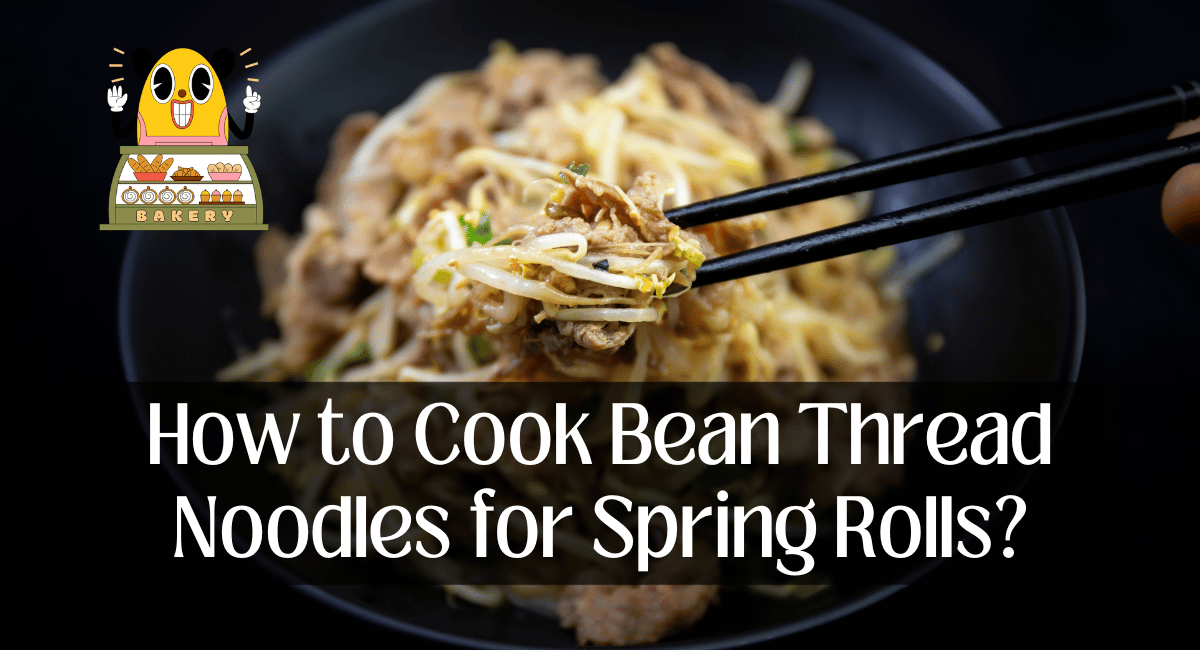Mastering the art of mixing different flavors and textures is required to make excellent spring rolls. The translucent and delicate bean thread noodles are a vital component of these delectable delicacies.
These noodles, also known as glass noodles or cellophane noodles, are a staple in many Asian cuisines and are prized for their ability to absorb the tastes of the dishes with which they are served.
We’ll walk you through the steps of making bean thread noodles for spring rolls, ensuring that they’re correctly cooked, soft, and ready to enhance the overall taste and satisfaction of your gourmet creation.
Whether you’re a seasoned chef or a novice in the kitchen, learning how to prepare bean thread noodles will certainly improve your spring roll game. Let’s get started and discover the secrets to excellent spring rolls!
How to Cook Bean Thread Noodles for Spring Rolls?
Certainly! Because of their translucent look and delicate texture, bean thread noodles, also known as cellophane noodles or glass noodles, are a favorite element in spring rolls. Here’s how to prepare them for spring rolls:
Ingredients:
- Bean thread noodles
- Water for boiling
- Pinch of salt (optional)
- Large bowl of ice water (for cooling)
To Boil Water: To boil water, fill a saucepan all the way up with water, then bring it to a boil. You’re going to want to make sure you have enough water to completely cover the bean thread noodles.
Add Salt (Optional): If you choose, you can add a little bit of salt to the water that is already boiling. The flavor of the noodles may be improved as a result of this.
Soak Noodles: When the water reaches a boil, remove it from the heat. Put the bean thread noodles into the water that is already boiling in the pot. Check to see that all of the noodles are covered by the liquid.
Soak Time: About five to seven minutes should be spent allowing the noodles to soak in the boiling water. The exact amount of time needed to soak the noodles can change depending on the brand as well as the thickness of the noodles. The objective is to tenderize them without reducing them to a mushy consistency.
Check Readiness: After the allotted time has passed, the noodles should be evaluated for readiness by taking a single strand and tasting it. They should be pliable and translucent, yet have a bite that is just barely on the firm side.
Drain and Cool: When the noodles are done cooking, immediately use a fine-mesh strainer or colander to drain the cooking liquid from them. They should be washed under running cold water to cease the cooking process and bring down the temperature. To ensure that the noodles cool down uniformly, give them a gentle toss.
Ice Water Bath: Fill a big dish with ice water water and have it ready. After they have been drained and allowed to cool, place the noodles in the ice water bath. This helps to bring an immediate halt to the cooking process and prevents the noodles from being adhered to one another.
Drain Again: Drain Once the noodles have reached the desired temperature, remove them from the ice water bath and give them another thorough draining. You may get rid of any surplus water by giving the strainer a light shake.
Final Preparation: The final preparation involves the bean thread noodles, which may now be utilized whenever you want to make spring rolls. They, along with several other vegetables, proteins, and herbs, can be used as a filling ingredient.
How to Store Bean Thread Noodles for Spring Rolls?
When storing bean thread noodles for spring rolls, make sure they are completely cool and drained. To prevent sticking, lightly coat them with oil. Press out excess air before closing in an airtight container or sealable plastic bag. Keep cool and dry, and keep out of direct sunlight.
For maximum freshness and texture, use within a day or two. If storing for a longer period of time, refrigerate and use within 3-4 days. If the noodles have been stuck together, carefully release them before using.
Tips for making bean thread noodles for spring rolls
To get the most out of your bean thread noodles for spring rolls, follow these guidelines:
Proper Soaking: Follow the soaking time specified on the box. Over-soaking might result in mushy noodles, while under-soaking can result in rough noodles. Taste to ensure the desired texture.
After soaking, rinse the noodles with hot water to remove extra starch and keep them from becoming too sticky.
To stop the cooking process, quickly immerse the cooked noodles into icy water after rinsing. This keeps them transparent and prevents them from getting too soft.
Drain thoroughly: After soaking and cooling, make sure the noodles are well drained. The flavors in your spring rolls may be diluted if you use too much water.
Prevent Clumping: To prevent clumping, toss the cooled and drained noodles with a little oil. This makes it easier to collaborate with them in the future.
If the noodles become stuck together, gently separate them with your fingers or a fork. A light oil coating can also help to avoid this problem.
Filling Varieties: For texture and flavor contrast, consider adding a range of colorful veggies, herbs, and proteins to your spring rolls.
Moist Cloth: Keep a moist cloth nearby while building your spring rolls to cover the rice paper sheets and final rolls. This helps to keep the sheets from drying out and splitting.
Rolling Method: Arrange the noodles and other contents in the bottom third of the rice paper sheet, allowing enough room on the sides for folding. Tuck in the sides and roll securely yet gently.
Serve immediately: Spring rolls are best eaten fresh. If you make them ahead of time, cover them with a moist towel and plastic wrap to keep them from drying out.
Dipping Sauces: To compliment the flavors of the spring rolls, make a variety of dipping sauces such as peanut sauce, hoisin sauce, or sweet chili sauce.
Experiment: Play around with your fills and presentations. Fresh herbs, shredded fruits, or even cooked shrimp or tofu can be added to improve the flavor and visual appeal.
Health Advantages
Mung beans and mung bean thread noodles are high in minerals and vitamins, including:
- Mung beans are high in a variety of minerals, including manganese, potassium, magnesium, folate, copper, zinc, and B vitamins.
- Eating bean thread noodles can assist your body in cell maintenance and repair.
- They are high in antioxidants and can help prevent chronic diseases.
- Mung beans and mung bean thread noodles are high in calcium and phosphorus, thus eating them can help you have strong bones and teeth.
- They can also aid in the prevention of lifestyle-related health problems such as diabetes.
- Mung bean fiber can help with digestion.
Remember that bean thread noodles are delicate, so to avoid breaking them, handle them with caution. If you aren’t using the noodles right away, you can spray a small bit of oil over them to keep them from sticking.
Enjoy your nicely cooked bean thread noodles with your tasty homemade spring rolls!
Thanks for reading. I hope you find it helpful.

